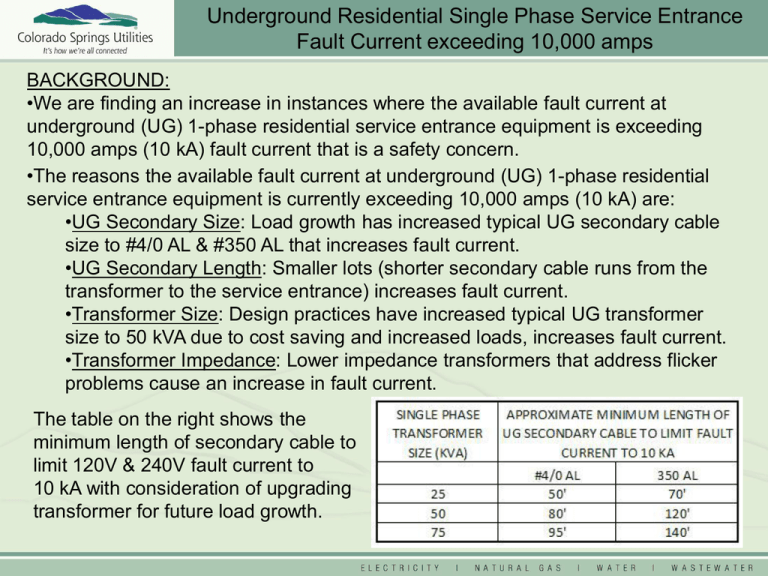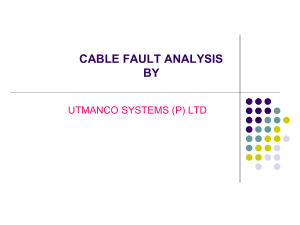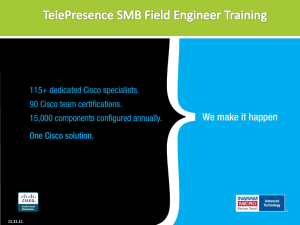Current Projects
advertisement

Underground Residential Single Phase Service Entrance Fault Current exceeding 10,000 amps BACKGROUND: •We are finding an increase in instances where the available fault current at underground (UG) 1-phase residential service entrance equipment is exceeding 10,000 amps (10 kA) fault current that is a safety concern. •The reasons the available fault current at underground (UG) 1-phase residential service entrance equipment is currently exceeding 10,000 amps (10 kA) are: •UG Secondary Size: Load growth has increased typical UG secondary cable size to #4/0 AL & #350 AL that increases fault current. •UG Secondary Length: Smaller lots (shorter secondary cable runs from the transformer to the service entrance) increases fault current. •Transformer Size: Design practices have increased typical UG transformer size to 50 kVA due to cost saving and increased loads, increases fault current. •Transformer Impedance: Lower impedance transformers that address flicker problems cause an increase in fault current. The table on the right shows the minimum length of secondary cable to limit 120V & 240V fault current to 10 kA with consideration of upgrading transformer for future load growth. Underground Residential Single Phase Service Entrance Fault Current exceeding 10,000 amps OPTIONS: • The options we have considered to address limiting the fault current to 10,000 amps in underground residential 1-phase service entrance equipment are: •A) Extending Secondary Cable Length: •Utilities could extend the secondary cable length by coiling up the cable at the property line. Concerns and limitations are: •Difficulty locating and marking the cable at coiled location. •Difficulty repairing a cable failure or cable cut at the coiled location. •Utilities Field Engineering and Crews would not know the minimum length of cable to be coiled since the meter location would not be known at time of design or secondary cable stub installation. •Licensed Utility Cable Installer (LUCI) could extend the secondary cable length by running a longer trench. Concerns and limitations are: •Difficulty locating and marking the cable location. •It would be the LUCI’s responsibility to determine the minimum required length of cable to install since Utilities Field Engineering would not know the meter location at time of design. •Difficulty inspecting and enforcing the minimum length of cable. •Cost of adding extra length of cable and trenching. Underground Residential Single Phase Service Entrance Fault Current exceeding 10,000 amps OPTIONS: •B) Reduce Secondary Cable size: •Utilities could reduce the secondary cable size from #4/0 to #1/0 on short service runs. Concerns and limitations are: •#1/0 AL will not work for a 200 amp service in duct. #1/0 AL Triplex has a ampacity of 215 amps (direct buried) and of 160 amps (in duct). •If installing a 50 kVA transformer with #1/0 AL Triplex the minimum length of cable to limit fault current to 10 kA is 45’ and could be a problem. •Utilities Field Engineering would not know the length of cable since the meter location would not be known at time of design. •C) Current Limiting Fuses (CFL) on Secondary Cable within Transformer: •Utilities could install current limiting fuses on the secondary cable within the transformer compartment. Concerns and limitations are: •This would add steps and time to the Troubleshooters ability to locate a secondary fault. •How would Utilites Field Engineering and Crews determine which services to add CFLs since meter location would not been know at time of transformer installation. •Cost of adding secondary CFLs. Underground Residential Single Phase Service Entrance Fault Current exceeding 10,000 amps OPTIONS: •D) Change metering to require a 22,000 amp Short Circuit Current Rating (22k SCCR) Meter with Main Breaker combination with either an All-in-One combination meter housing with main breaker load center or Metered Main combination meter housing with main breaker and a seperate sub panel load center: •Utilities could require the use of an All-in-One Meter or Metered Main that is rated at 22k SCCR. Concerns and limitations are: •Additional cost of All-in-One Meter or Metered Main vs. seperate meter socket and load center for electrician and contractors. •Do we require all new services to install an All-in-One Meter or Metered Main due to the ability of Utilities Inspectors and Regional Building Department Inspectors to determine and enforce which services exceed the 10 kA fault current and will require the All-in-One Meter or Metered Main enclosures. Underground Residential Single Phase Service Entrance Fault Current exceeding 10,000 amps PROPOSAL: • We propose to change our metering standard to require all new underground residential single phase services to install either an All-in-One Meter socket with Load Center or a Metered Main socket with main breaker and seperate sub panel Load Center. All-in-One and Metered Main Meter Solution: • Allows up to 22 kA fault current that eliminates problem with exceeding 10 kA fault current. •Allows for future transformer upgrades due to load increase (Example: Electric Cars) •Provides Fire Department with an outdoor disconnect. Table below shows a rough cost comparison based on online costs at Home Depot or Lowes department stores. Underground Residential Single Phase Service Entrance Fault Current exceeding 10,000 amps All-in-One Metered Load Center Metered Main with Sub Panel




